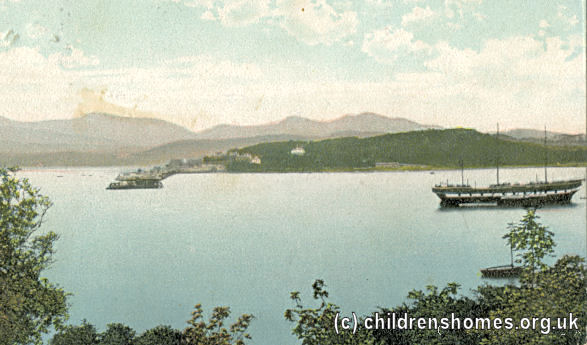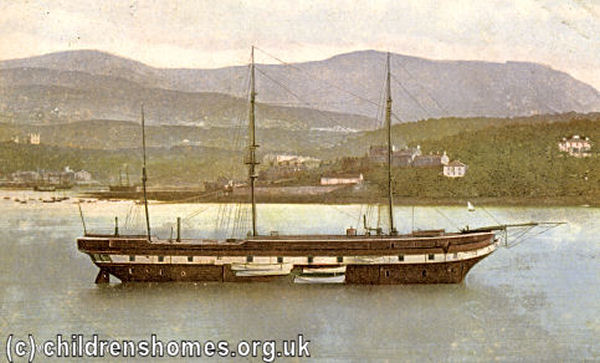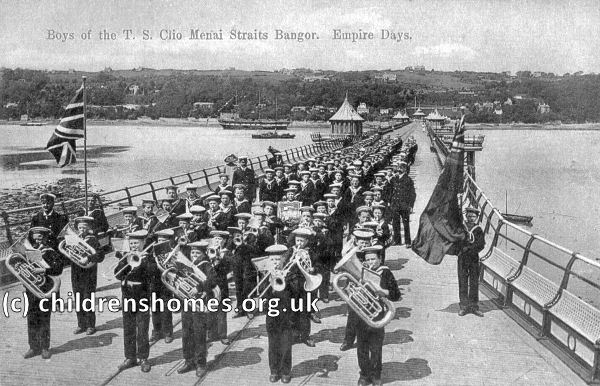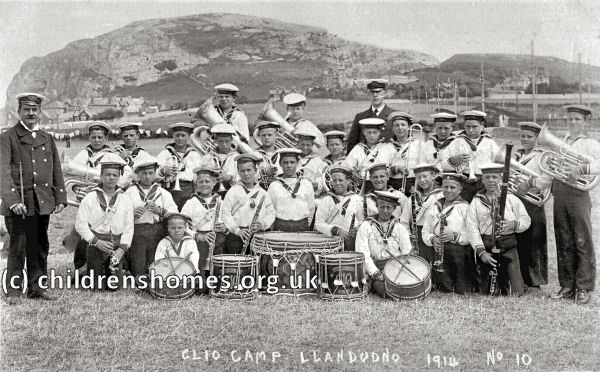Industrial School and Training Ship 'Clio', Liverpool, Lancashire
In 1876, Captain William Milner Moger, R.N., initiated a scheme to set up a naval training ship for homeless and destitute boys of good character from North Wales, Chester and the Border Counties. He formed a charity, the City of Chester and Border Counties Training Ship Society, to oversee and raise funds for the project, with the Duke of Westminster agreeing to become its President and Chairman.
A vessel for the purpose, the Clio, was lent by the Admiralty. The former warship was described as a screw corvette, indicating that she had steam power, square-rigged masts and a single open gun deck. Built in 1858 to carry eighteen 65-pounders, she had a length of 200 feet, a breadth of 40.5 feet, and a hold depth of 22.75 feet. After being refitted for her new role, which included the removal of her engines,she was moored on the Anglesey side of the Menai Straits, almost opposite Bangor.

T.S. Clio off Bangor, c.1909. © Peter Higginbotham
An opening ceremony aboard the vessel took place on 20 August 1877 and she was formally certified to begin operation as an Industrial School on 29 August, with accommodation for 260 boys aged from 11 to 16 years, who were usually admitted at the age of 12 or 13. Although most of these would be placed by magistrates, voluntary cases could also be admitted. A charge of 8s. a week was made for each inmate. Captain Moger was appointed Captain-superintendent of the establishment.
A report following an official inspection in 1879 found the ship in first-rate condition. A large swimming bath had been constructed below deck. There were 246 inmates, comprising 233 who were under detention and 13 voluntary cases. The boys received instruction in sailmaking, knotting, splicing, slinging, compass, rule of the road, lights and signalling, canvas bag making, etc. Gunnery instruction was also provided for. There was a tailoring class, with a few boys learning shoemaking. Apart from Captain Moger, the staff comprised the Chief Officer, Mr Delaney; the schoolmaster, Mr Hall; assistant schoolmaster, Mr Jackson; four seamen instructors and a cook.
An inspection ten years later, in 1889, recorded that the establishment was maintaining its foremost position for 'special and high-class efficiency'. A covered play-deck was also used as a gymnasium, and was particularly useful in rough weather. There was a comfortable sick bay in case of need. It was noted that the vessel's location was somewhat exposed and the boys required all possible protection in the winter months. During the previous year there had been an outbreak of scarlet fever affecting 16 boys in total, who were dealt with in a hospital ship. There had also been instances of sore eyes, diarrhoea, sore throat, a case or two of eczema, one of jaundice, one debility, one case of a scalded leg, and one of pneumonia. The record of punishment was 'still a considerable one' with various offences of disorder, theft, bad language, bullying, lying, trickery, and use of tobacco. About 20 to 25 boys were punished monthly, the remainder keeping themselves free. Gunnery drill, rifle drill and cutlass drill now formed part of the industrial training. During the summer months the boys were taken up on the rigging, but in winter practised on the yards on the main deck. Boys working with the tailor and shoemaker produced most of the ship's clothing. Some worked with the carpenter and some with the cook. Classroom performance was said to be generally good, with subjects tested including reading, writing, dictation, the geography of the British Isles, and the physical geography of Europe. A total of 36 former inmates had gone to sea in 1889. The staff mow comprised: Captain Moger; chief officer, Mr John Delaney; chief schoolmaster, Mr. W Milliard; assistant schoolmaster, Mr C Lee and Mr C Stevens; clerk, Mr. Wells; six seamen instructors, one gunnery instructor, tailor, shoemaker, two carpenters, cook and storekeeper, sick bay attendant, night watchman, agent in Liverpool.
By the 1890s, the Clio had become a national institution, its intake including boys from Manchester, Lancaster and Birmingham.
A report in 1896 noted that some of the decks were beginning to show signs of age. However, the vessel was judged sound and was kept in an admirable state. The ship was said to be ingeniously lit by means of side skylights which ran right down to the hold. The swimming bath, which occupied the vessel's old engine room, could not be used in the winter. The hurricane deck, which covered the width of the ship from the mainmast to the prow, provided an open air playground above and a covered playground below. Some parallel and horizontal bars were fitted up under the hurricane deck, but no regular instruction was given. The ship had no playing-field of its own. Boys occasionally went to the public ground at Gallows Point although, being 1.5 miles away, this was of limited use. The guns were of an obsolete design but useful for exercise. The ship had no tender but a pinnace, rigged fore and aft was managed by the boys and one officer to fetch water in all weathers, almost daily. Nautical instruction was well attended to on board; sails were bent to the foremast in the summer, and there was a monkey topsail for beginners on the mainmast. Practice in the winter was carried on on a topgallant sail within reach of the maindeck. The ship was well supplied with boats and the boys practised rowing on fine evenings in summer and on fair days in other seasons. However, the boys were mostly too small to be of much use in a heavy sea. A classroom inspection included an appraisal of the boys' performance in recitation, word-building, mental arithmetic, history, geography and tonic-solfa singing. Numbers engaged in the various forms of industrial training were as follows: 22 tailors, 8 shoemakers 2 carpenters, 21 in the drum and fife band. A mark system was in operation, whereby good conduct resulted in rewards of between 2d. and 1s. a month for 60 boys. Quarterly prizes were given in the schoolroom and extra rewards for good work in the tailor's shop. The boys organised an entertainment for themselves each week in the winter months and an occasional lantern entertainment was given by the captain. Two ladies and some other friends in the neighbourhood provided the boys with an occasional treat. There was a good library on board. All the boys were taken to Llandudno or some other seaside resort for a day trip each summer.
In 1898, the ship's own swimming bath was replaced by an onshore one, about half a mile away, which could be heated.
Captain Moger resigned owing to ill health in 1899. He was succeeded as superintendent by Commander Frederick C.G. Langdon, R.N. In the same year, an onshore playing field was acquired. Drawing had now been added to the industrial training. It was also noted that the boys' boat-pulling had greatly improved.
A report in 1906 recorded that two Q.F. guns had been loaned from the Admiralty for drill purposes, while a miniature rifle-range had been provided by the Lord Bishop of Bangor in his own grounds. The ship's 20 M.H. rifles had been replaced by L.M. rifles, with two Morris tubes and targets. Physical training was now carried out on the Swedish system adopted by the Royal Navy. The previous summer, the boys had gone to camp at Llandudno, something which had become an annual event.

T.S. Clio, c.1909. © Peter Higginbotham

T.S. Clio boys and band on Bangor Pier, c.1910. © Peter Higginbotham

T.S. Clio band at camp, Llandudno, 1914. © Peter Higginbotham
In 1917, the Clio broke from her moorings and drifted down the straits. It was only beacuse she was connected to the shore by a very strong telephone cable that she was not carried further afield. The cable had the effect of gently guiding her to the Anglesey coast where she grounded on a level keel on soft mud. She was later towed back to her mooring by the steamer Pride of the Weaver.
In 1919, the deteriorating condition of the vessel and the a steady decline in numbers being placed there the ship, resulted in the closure of the establishment. The following year, she was released from her anchorage and towed to Bangor to be broken up.
In around 1890, an Auxiliary Home was opened at 18 Hardy Street, Liverpool. It acted as a hostel for those taking up employment in the city and also for former Clio boys who needed short-term accommodation while their ships were in port. By 1900, it had been replaced by premises at 6 Great George's Square, Liverpool, where up to 30 boys could be accommodated.
Records
Note: many repositories impose a closure period of up to 100 years for records identifying individuals. Before travelling a long distance, always check that the records you want to consult will be available.
- Anglesey Archives, Industrial Estate Road, Bryn Cefni Industrial Estate, Llangefni, Anglesey LL77 7JA.
Census
Bibliography
- Carridice, Phil Nautical Training Ships: An Illustrated History (2009, Amberley Press)
- Higginbotham, Peter Children's Homes: A History of Institutional Care for Britain's Young (2017, Pen & Sword)
Links
- None identified at present.
Except where indicated, this page () © Peter Higginbotham. Contents may not be reproduced without permission.


